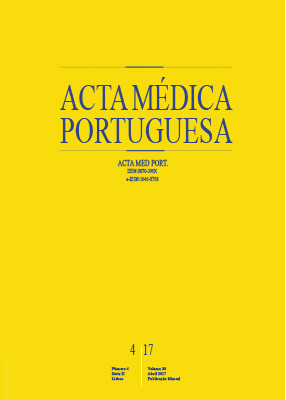Efficacy and Safety of Foley Catheter Balloon for Cervix Priming in Term Pregnancy
DOI:
https://doi.org/10.20344/amp.8003Keywords:
Catheterization/methods, Cervical Ripening, Labor, InducedAbstract
Introduction: Foley catheter promotes cervix priming by a direct mechanical effect of distension.
Material and Methods: A prospective observational study was conducted at a tertiary hospital, including all cases of induction of labor with Foley catheter between September 1, 2013 and November 30, 2015. Women were eligible if they had a singleton pregnancy with a Bishop score < 6 and a gestational age ≥ 41 weeks or a medical indication for induction of labor. The primary outcome was the Bishop score variation (difference between Bishop score before and after insertion of Foley catheter). Mode of delivery, induction-to-delivery time, uterine tachysystole with fetal decelerations, peripartum fever ≥ 38º C, maternal pain and mortality were also analyzed.
Results: Within 201 inductions with Foley catheter, average increase in Bishop score after catheter placement was three (1 - 7), with only 5% (11/201) of unmodified cervix after catheter removal/extrusion. Vaginal delivery rate was 71% (142/201) and in women with a previous cesarean section (n = 40) was 37% (15/40). Average induction-to-delivery time was 38 hours (4 - 120). Uterine infection rate was 3% (6/201). There was only one case of significant vaginal bleeding which required immediate catheter removal. There has been no significative maternal or neonatal morbidity.
Discussion/Conclusion: Foley catheter is a safe and effective method of cervical priming for women with an unfavorable cervix, even in the case of a previous cesarean delivery.
Downloads
Downloads
Published
How to Cite
Issue
Section
License
All the articles published in the AMP are open access and comply with the requirements of funding agencies or academic institutions. The AMP is governed by the terms of the Creative Commons ‘Attribution – Non-Commercial Use - (CC-BY-NC)’ license, regarding the use by third parties.
It is the author’s responsibility to obtain approval for the reproduction of figures, tables, etc. from other publications.
Upon acceptance of an article for publication, the authors will be asked to complete the ICMJE “Copyright Liability and Copyright Sharing Statement “(http://www.actamedicaportuguesa.com/info/AMP-NormasPublicacao.pdf) and the “Declaration of Potential Conflicts of Interest” (http:// www.icmje.org/conflicts-of-interest). An e-mail will be sent to the corresponding author to acknowledge receipt of the manuscript.
After publication, the authors are authorised to make their articles available in repositories of their institutions of origin, as long as they always mention where they were published and according to the Creative Commons license.









